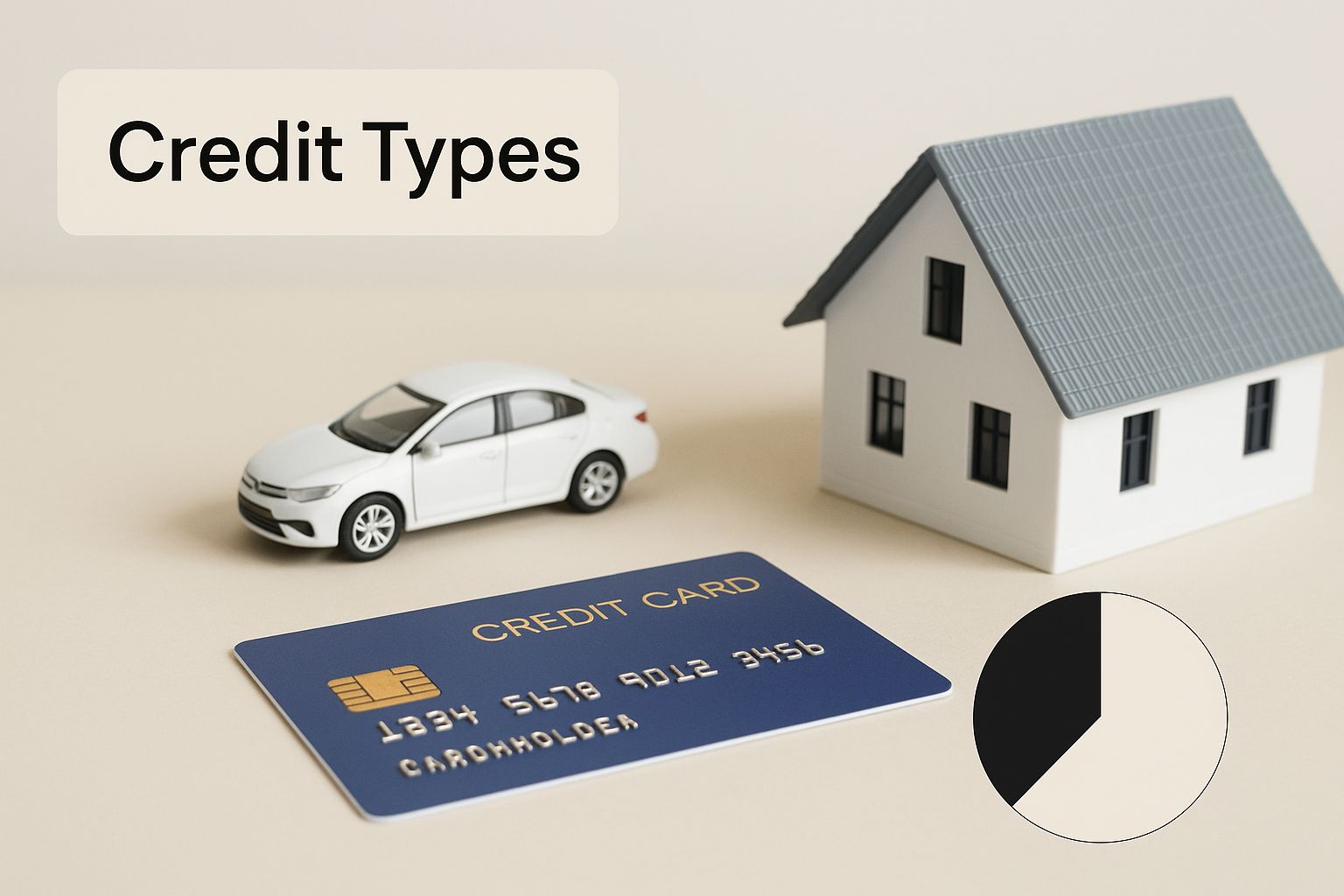What Is Credit Mix? Boost Your Credit Score Today

When you hear the term "credit mix," what does it actually mean? Think of it like a financial portfolio. Instead of stocks and bonds, you have different types of credit accounts, like credit cards and loans. Lenders want to see that you can handle a variety of financial responsibilities, not just one. A healthy mix suggests you're a reliable and experienced borrower.
Understanding Credit Mix and Why It Matters

Imagine you're a basketball coach scouting new players. One player is a phenomenal three-point shooter but can't do much else. Another player might not be the best shooter, but they can shoot, dribble, pass, and play solid defense. Who seems like the more dependable, well-rounded player? It’s the same with your credit.
Credit scoring models, like the ones from FICO and VantageScore, reward borrowers who show they can manage different kinds of debt. Having a history with both revolving credit (where you can borrow and repay repeatedly, like a credit card) and installment loans (with fixed payments for a set term, like a car loan) proves your financial versatility. It's not the biggest piece of the credit score pie, but it helps paint a fuller picture of your financial habits for lenders.
The 10% Rule of Credit Mix
So, how much does this variety actually move the needle on your score? Your credit mix makes up about 10% of your FICO credit score. It might not sound like a lot, especially when you compare it to the massive 35% that payment history commands. But that 10% can be just enough to nudge a "good" score into the "excellent" range. For more detail, you can dig into what credit management experts on CreditCards.com have to say about this.
This is especially critical for anyone new to the U.S. credit system, such as ITIN holders. When you're building a credit history from the ground up, every single component matters. Proving you can juggle a credit card and, down the road, a small personal or auto loan can fast-track your path to better financial opportunities. A solid mix signals to lenders that you're a lower-risk borrower, which is the key to unlocking better interest rates and loan terms in the future.
The Two Main Types of Credit You Need to Know
To really get a handle on your credit mix, you first need to know about the two main ingredients that make it up. Think of them as the fundamental building blocks of your credit history. Lenders look at these distinct types of debt to see how experienced you are at managing different kinds of financial obligations.
The two main players are revolving credit and installment credit. Let's break them down.

Revolving Credit
Revolving credit is probably what you're most familiar with—think of a credit card. It’s like having an open line of credit that you can draw from, pay back, and then draw from again. You get a set credit limit, but your monthly balance and minimum payment fluctuate based on what you spend and repay.
The key to managing revolving credit is to keep your balance low compared to your total limit. Lenders see this as a sign of financial responsibility; it shows you aren't maxing out your cards just to get by.
Installment Loans
On the other side of the coin, you have installment loans. These are much more straightforward. You borrow a specific amount of money for a specific purpose and agree to pay it back in equal, fixed payments over a set period.
Common examples include:
Once you make the final payment, the loan is paid off and the account is closed. This predictable structure proves to lenders that you can handle a long-term financial commitment and make consistent, on-time payments month after month.
Juggling both of these account types successfully is what a good credit mix is all about.
To make the distinction crystal clear, let's compare them side-by-side.
Revolving Credit vs. Installment Loans
As you can see, each type serves a different purpose and demonstrates a different kind of financial discipline. Having both in your credit report gives lenders a more complete and positive picture of your ability to manage debt.
How Credit Mix Actually Shapes Your Score
So, why does the combination of accounts you have even matter to lenders? It all comes down to one thing: predicting how reliable you'll be with their money. Credit scoring models, like the ones from FICO and VantageScore, look at your ability to juggle different kinds of debt at the same time. Successfully managing them is seen as a hallmark of financial experience and maturity.
Here’s a good way to think about it. Making your payments on time is the absolute baseline—it’s like showing up to work every day. But having a good credit mix is like proving you can handle several different projects at once, and do them all well. It shows you’re not a one-trick pony, which tells lenders you’re a lower-risk person to lend to.
Beyond the 10% Rule
Officially, your credit mix makes up about 10% of your FICO score, but its real-world impact often feels much bigger. A strong mix can actually boost the power of your other good habits. Think about it: making consistent, on-time payments on both a credit card and a car loan looks a lot more impressive than just making payments on one of those accounts alone.
This kind of synergy paints a more complete, positive picture of your financial life. It’s a key piece of the puzzle that builds trust with lenders, making them more comfortable offering you bigger loans down the road. To get the full picture, it helps to understand all the moving parts; our guide on what is a credit score breaks down every factor involved.
At the end of the day, a healthy credit mix lowers the lender's perceived risk. For you, the borrower—especially if you're building credit with an ITIN—that translates into tangible benefits. It can be the very thing that gets you approved for a mortgage or a car loan, and often with better interest rates that save you serious money over time.
How to Build a Healthy Credit Mix Strategically

Putting what you know about credit mix into practice isn't about quick fixes; it's about playing the long game. The single most important rule is to let your credit mix grow organically as your financial life changes. Never, ever take on debt just to try and pump up your credit score.
A smart, patient approach is what really works. You want to show lenders you can handle different kinds of financial obligations, but only when it actually makes sense for you to have them. This is how you build a credit profile that's not just strong, but sustainable for the long haul.
Starting Your Credit Building Journey
If you're at square one with building credit—which is a very common starting point for ITIN holders—the goal is to create a solid foundation, usually with revolving credit. There’s no need to dive into a major loan right away.
Here are a couple of excellent tools to get started:
These products were designed for one purpose: to help people establish the credit history they need for a good score. Pick one, use it consistently, and always pay on time. That's a powerful first move. If you're curious about what milestones to aim for, our guide on what is considered good credit is a great resource.
Adding an Installment Loan Naturally
Once you’ve gotten comfortable with managing revolving credit, adding an installment loan might be the next logical step. But don't rush it. The key is to wait until a real need comes along, like financing a car or making a necessary large purchase.
When that day arrives, the history of responsible credit card use you’ve already built will make a huge difference in getting approved.
Ultimately, financial experts agree: don't open new accounts just to improve your credit mix. The hard inquiries and the potential for missed payments can do more harm than good. As you can see from Experian's take on credit mix, the best credit profiles are always built over time by responsibly managing the debts you actually need.
Common Credit Mix Myths That Can Hurt Your Score
When you're working to build a solid financial life, especially with an ITIN, it's easy to get tangled up in bad advice. The world of credit is full of well-meaning "tips" that can actually do more harm than good. Believing these common myths about credit mix can easily derail your progress and damage the very score you're trying to raise.
One of the biggest misconceptions is that you need a huge variety of accounts to have a good credit mix. Some people think they need to juggle a mortgage, a car loan, a personal loan, and a wallet full of credit cards all at once. Not only is this untrue, but it's a surefire way to get overwhelmed financially.
A simple, well-managed combination is really all you need to show you can handle different types of credit.
The Dangers of Closing Old Accounts
Here’s another piece of popular—but terrible—advice: close your old, unused credit cards. On the surface, it makes a certain kind of sense. If you aren't using an account, why keep it open? But taking this step can backfire, hurting your score in two major ways.
First, closing an old card immediately slashes your total available credit. This can push your credit utilization ratio up, which is a big red flag for lenders and can make your score drop. Second, and maybe even more importantly, it shortens your credit history. The length of your credit history is a key piece of your score, so closing your oldest account is like ripping out a chapter of your financial story.
To see how all these pieces fit together, take a look at our detailed guide on the factors affecting your credit score. Getting the full picture will help you steer clear of these kinds of traps. Your best move is to keep old accounts with no annual fee open. You can even use them for a small, recurring purchase every few months just to make sure the bank keeps them active.
Common Questions About Credit Mix
Even with the basics down, you might still wonder how all this credit mix stuff applies to you. That's completely normal. Let's walk through some of the most common questions people have so you can build your credit with confidence.
How Many Accounts Do I Actually Need?
There’s no magic number. Lenders aren't just counting your accounts; they're looking at how well you manage them. A strong profile simply shows you can handle both revolving credit (like a credit card) and installment credit (like a car or personal loan).
Honestly, having just one of each that you pay on time, every time, is way more impressive than having a dozen accounts you can barely keep track of. The goal is quality over quantity.
This approach also keeps your finances much simpler and lowers the chances of a missed payment, which hurts your score far more than a "thin" credit mix ever would.
Should I Take Out a Loan Just to Boost My Score?
I get this question a lot, and the answer is almost always a firm no. It might seem like a clever shortcut to add an installment loan to your report, but this strategy can easily do more harm than good.
For one, every time you apply for a new loan, it triggers a hard inquiry, which can ding your score temporarily. More importantly, you're taking on real debt, complete with interest charges and the risk of late fees if your budget gets tight. The tiny potential bump to your credit mix just isn't worth the cost and the risk. It’s always better to build your credit mix organically as you actually need to borrow.
Do My Rent and Utility Bills Help My Credit Mix?
Typically, they don't. Your monthly rent and utility payments are usually seen as regular living expenses, not as credit accounts, so they don't show up on your standard credit report.
That said, things are changing. Services like Experian Boost now let you voluntarily add things like utility and even some streaming service payments to your Experian credit file. While this can definitely help by adding more positive payment history, these accounts aren't classified as "revolving" or "installment" credit. So, while they can be great for your overall credit health, they don't directly improve the 10% of your score dedicated to credit mix.
Ready to take control of your credit journey? itinscore is the first platform designed for ITIN holders, providing free credit monitoring and a personalized action plan to build your financial future. Sign up for free today at itinscore.com and start building the credit you deserve.